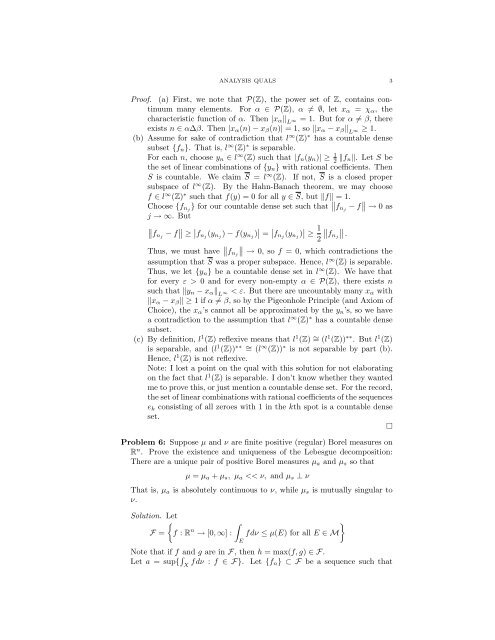ANALYSIS QUALIFYING EXAM PROBLEMS BRIAN LEARY ...
ANALYSIS QUALIFYING EXAM PROBLEMS BRIAN LEARY ...
ANALYSIS QUALIFYING EXAM PROBLEMS BRIAN LEARY ...
Create successful ePaper yourself
Turn your PDF publications into a flip-book with our unique Google optimized e-Paper software.
<strong>ANALYSIS</strong> QUALS 3<br />
Proof. (a) First, we note that P(Z), the power set of Z, contains continuum<br />
many elements. For α ∈ P(Z), α = ∅, let xα = χα, the<br />
characteristic function of α. Then |xα L ∞ = 1. But for α = β, there<br />
exists n ∈ α∆β. Then |xα(n) − xβ(n)| = 1, so xα − xβ L ∞ ≥ 1.<br />
(b) Assume for sake of contradiction that l ∞ (Z) ∗ has a countable dense<br />
subset {fn}. That is, l ∞ (Z) ∗ is separable.<br />
For each n, choose yn ∈ l ∞ (Z) such that |fn(yn)| ≥ 1<br />
2 fn. Let S be<br />
the set of linear combinations of {yn} with rational coefficients. Then<br />
S is countable. We claim S = l ∞ (Z). If not, S is a closed proper<br />
subspace of l ∞ (Z). By the Hahn-Banach theorem, we may choose<br />
f ∈ l ∞ (Z) ∗ such that f(y) = 0 for all y ∈ S, but f = 1.<br />
Choose {fnj } for our countable dense set such that fnj − f → 0 as<br />
j → ∞. But<br />
<br />
fnj − f ≥ fnj (ynj ) − f(ynj ) = fnj (ynj ) ≥ 1<br />
<br />
fnj .<br />
2<br />
Thus, we must have <br />
fnj → 0, so f = 0, which contradictions the<br />
assumption that S was a proper subspace. Hence, l∞ (Z) is separable.<br />
Thus, we let {yn} be a countable dense set in l∞ (Z). We have that<br />
for every ε > 0 and for every non-empty α ∈ P(Z), there exists n<br />
such that yn − xαL∞ < ε. But there are uncountably many xα with<br />
xα − xβ ≥ 1 if α = β, so by the Pigeonhole Principle (and Axiom of<br />
Choice), the xα’s cannot all be approximated by the yn’s, so we have<br />
a contradiction to the assumption that l∞ (Z) ∗ has a countable dense<br />
subset.<br />
(c) By definition, l1 (Z) reflexive means that l1 (Z) ∼ = (l1 (Z)) ∗∗ . But l1 (Z)<br />
is separable, and (l1 (Z)) ∗∗ ∼ = (l∞ (Z)) ∗ is not separable by part (b).<br />
Hence, l1 (Z) is not reflexive.<br />
Note: I lost a point on the qual with this solution for not elaborating<br />
on the fact that l1 (Z) is separable. I don’t know whether they wanted<br />
me to prove this, or just mention a countable dense set. For the record,<br />
the set of linear combinations with rational coefficients of the sequences<br />
ek consisting of all zeroes with 1 in the kth spot is a countable dense<br />
set.<br />
<br />
Problem 6: Suppose µ and ν are finite positive (regular) Borel measures on<br />
R n . Prove the existence and uniqueness of the Lebesgue decomposition:<br />
There are a unique pair of positive Borel measures µa and µs so that<br />
µ = µa + µs, µa
















